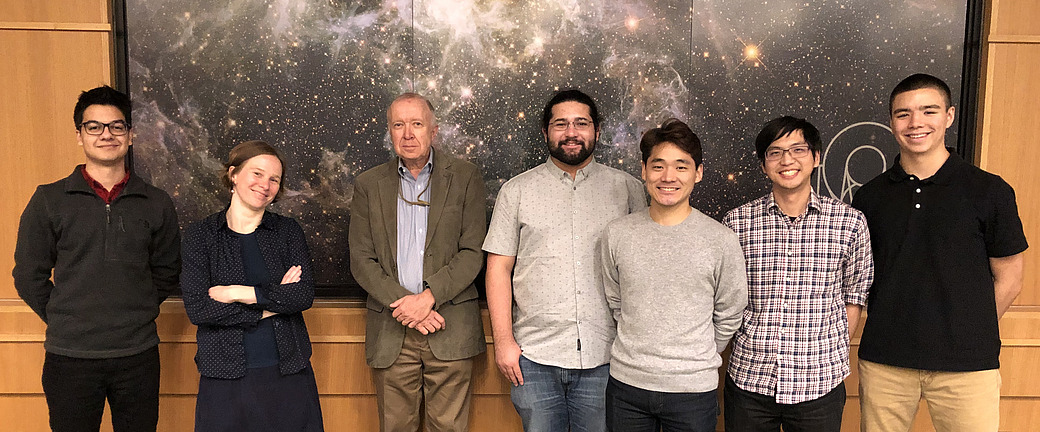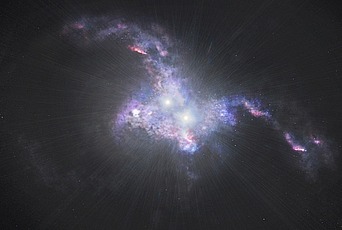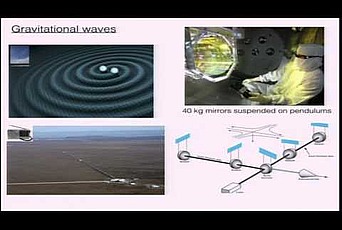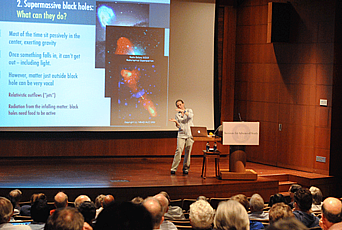Nadia Zakamska, returning Member in the School of Natural Sciences, is an astrophysicist studying a variety of astronomical wonders, ranging from extrasolar planets to extragalactic astronomy. Her current research focuses on long-standing puzzles in the evolution and dynamics of binary stars and on the discovery of binaries of compact stellar remnants.
Zakamska completed her Ph.D. at Princeton University (2001–05), then was a John N. Bahcall Fellow and NASA Spitzer Fellow at the IAS (2005–10), a Kavli Fellow at Stanford University (2010–11) and is now a professor at Johns Hopkins University. Her last long-term visit at the IAS was in 2016 as D. Lunder and A. Ezekowitz Junior Visiting Professor. This Q&A has been edited for length and clarity.
What question(s) within your field do you most want to answer and why?
I am an opportunist, and my interests are driven by advances in astronomical instrumentation and surveys. I think about what kinds of new and exciting data are newly available or will be available shortly, and then I get excited about the questions that can be addressed with these data. Therefore, the questions that most interest me change every few years as the field goes forward and new opportunities and facilities open up. Some of them are “big picture” questions that have baffled the field for decades, and some are just topics of personal curiosity.
I am fascinated by the most extreme, rare objects—the most luminous quasars, the most powerful galactic winds, the shortest period binaries—which often represent extreme conditions which teach us something new about the physics of the universe.
For about ten years, I have worked primarily on the cosmic evolution of supermassive black holes and their host galaxies. Such black holes are present in centers of most, if not all, massive galaxies including ours and are now understood to play a major role in galaxy formation. Together with my research group, I obtained some of the key first observations illustrating how exactly this connection occurs and elucidated the physics of the processes involved. When cosmic gas falls into the black hole, it emits copious light before its final plunge, producing a so-called quasar—an extremely powerful source of radiation visible out to great distances. The pressure from this radiation pushes out the remaining galactic gas and launches so-called galactic winds. We obtained observations of such quasar-driven winds across the electromagnetic spectrum and discovered some of the most extreme winds in the universe. I am now eagerly anticipating the upcoming launch of the James Webb Space Telescope. Its unprecedented sensitivity and ability to detect infrared radiation will be revolutionary for studying distant quasars which were active at the epoch when galaxies were forming most rapidly.
In the last few years I have become increasingly interested in close stellar binaries—objects where two stars orbit around a common center of mass, sometimes on extremely short-period orbits—hours or minutes. Binaries of stellar remnants—white dwarfs, neutron stars and black holes—are responsible for bursts of gravitational waves seen by the Laser Interferometer Gravitational-wave Observatory, for Type Ia supernova explosions and for other important astrophysical phenomena. There are many gaps in the current understanding of the formation and evolution of such binaries, and I think a lot of progress can be made in this field now thanks to ongoing and upcoming variability surveys—automated sky surveys detecting variable and transient astronomical sources—and unprecedented spectroscopic surveys of millions of Galactic stars. If there is one question I have to single out as a major unresolved problem in the field that I would like to tackle, it's the origin of Type Ia supernovae. These transients are ubiquitous and critically important in astronomy—they were used as cosmological standard candles in the discovery of dark energy—yet the nature of their progenitors has remained a stubbornly unsolved question for decades.

Another theme underlying my scientific interests is astrophysical extremes. In astrophysics we get to study the extremely rarified gas on the largest scales of the Universe as a whole, as well as the densest matter in white dwarfs and neutron stars, all over many orders of magnitude in temperature and physical scales. I am fascinated by the most extreme, rare objects—the most luminous quasars, the most powerful galactic winds, the shortest period binaries—which often represent extreme conditions which teach us something new about the physics of the universe.
How do you describe your work to friends and family?
"I am drowning in emails and I have a telescope proposal deadline tomorrow."
Who or what has had an outsized influence on you in your academic career?
First the ‘what’—that was undoubtedly the decision to move from Russia to pursue my Ph.D. in Princeton in 2001. I received an excellent education at the Moscow Institute of Physics and Technology, I did undergraduate research at Lebedev Physical Institute, which was a warm and welcoming place, and I am still in touch with some of my professors. These places are full of passionate and talented people who provide first-class science education despite (what I think is) enormous bureaucratic and financial adversity. But knowing what I know now, I don't think that I would have been able to pursue research if I'd stayed in Russia. I'd always known that I wanted to have children. In 2001, I was a young mother of a newborn daughter. Looking back at the economic and political chaos in Russia in the last 30 years and knowing how difficult the daily life of parents of young children there is, I know that I would have prioritized securing every opportunity for my family and I wouldn’t have had enough brain space to continue serious research. To paraphrase Russian poet Mayakovsky, the boat of curiosity would have crashed against the everyday. Both science and family are integral to who I am now. It has been by no means easy to raise a family of three children in the United States while pursuing an active research career, but it was ultimately possible without sacrificing either one in favor of the other.
Now to the ‘who’. I have had the privilege of having several brilliant and supportive mentors and colleagues, but at the top of the ‘outsized influence’ category—both as a scientist and as a mentor—would be Scott Tremaine, who recently retired from a professorship at the IAS and who was the Chair of Princeton Astrophysics when I arrived there as a graduate student. At the time when many fields evolve toward ever-increasing specialization, with his own breadth and depth of knowledge of physics and astrophysics, Scott served as an important role model to several generations of Princeton students and postdocs and IAS members. I continually aspire to maintain fresh knowledge across many areas of astrophysics thanks to his example. Scott provided invaluable career advice and support at every stage. I am sure his hallmark questions—“Why is this interesting?” and “It's too cute, why hasn't somebody done this before?”—will be remembered with a chuckle and taught to new generations of researchers across the country for decades to come.

What is one of your most memorable moments as an academic?
Several times during my academic life, I had ‘eureka’ moments, when I discovered something interesting in the data or figured out something about the underlying physics with crystal clarity for the first time, and I remember how satisfying these moments were. Amusingly, ‘eureka’ is a very private moment, because it takes weeks or months from that point to get the publication out to the scientists, or the press release out to the public, so for a few minutes you just sit there as the only person in the world who knows about it, then you might send an email to a collaborator or two, and the best collaborators are those who can immediately appreciate the significance of the finding and respond “this is awesome.” When I started graduate school, I thought I was going to become a theorist, but the “high of discovery” that I experienced when working with astronomical data became too much of a temptation—I think I inherited that from my thesis advisor Michael Strauss, a former IAS member and now Astrophysics Chair at Princeton, another scientist with an outsized influence on my path.
I remember feeling elated on several occasions when I got prizes or other forms of recognition, or at some presentations that I've delivered that resonated with the audience. One particularly memorable one was a public talk here at the IAS in 2013 which seemed to be of strong interest.
A couple of years ago I was visiting a university in Europe, and an undergraduate student asked me what was the accomplishment I was most proud of. Until then, in a mad rush to get everything done at some non-embarrassing standard—my own research, student supervision, teaching, endless presentations and proposals—while raising small kids, I'd never really had time to reflect on what, if anything, there was to be proud of and on what, if anything, had been accomplished. In trying to answer this question, I realized that I was indeed particularly enthusiastic about some of my papers, but it seemed an inadequate response. So, I responded that the most important accomplishment was to have been able to have an intellectually satisfying job and a family I wanted. This has definitely been a team effort with my husband, and much of the credit for this outcome lies with him.
What other activities or pastimes do you enjoy?
I am working on my second novel as I am trying to find an agent for my first. So, if anybody has ideas for an agent interested in a crime story in a campus setting (I know, a shocking topic for somebody with my background...), please let me know!
I enjoy traveling and learning about the history and culture of the places I visit, being in nature (although not the mosquitos) and reading (almost exclusively modern literary and upmarket fiction). To this day I feel privileged that I have the luxury of ‘pastimes’. Neither the financial capability to travel nor having enough time to pursue interests outside of work were foregone conclusions in my younger years.
Published in The Institute Letter Fall 2021.


